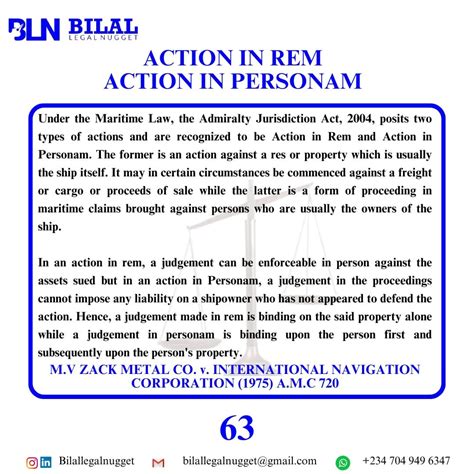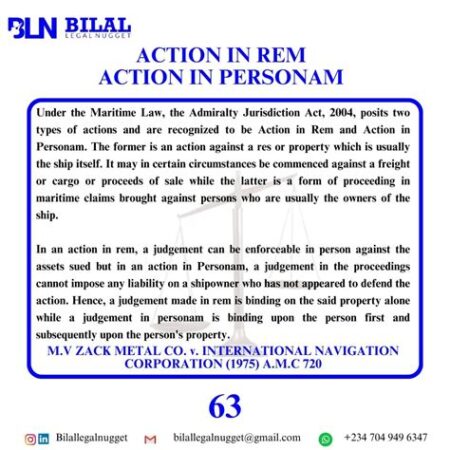
- Introduction
- Section 1: What is Action in Rem?
- Section 2: When to File an Action in Rem
- Section 3: Procedures in an Action in Rem
- Section 4: Table: Overview of Action in Rem Maritime Law
- Conclusion
-
FAQ about Action In Rem Maritime Law
- What is an action in rem?
- What types of cases can be brought as an action in rem?
- What are the benefits of an action in rem?
- Who can file an action in rem?
- What is the process for filing an action in rem?
- What happens after the property is arrested?
- How is an action in rem resolved?
- What happens if the plaintiff wins the case?
- What are some defenses to an action in rem?
- What are the limitations of an action in rem?

Introduction
Greetings, readers! Welcome aboard our deep dive into the fascinating world of action in rem maritime law. In this comprehensive guide, we’ll set sail to unravel the complexities of this specialized legal field, providing you with a thorough understanding of its concepts, procedures, and implications.
Maritime law, a branch of law that governs the relationships and activities within maritime commerce, encompasses various legal doctrines and remedies. One such remedy is an action in rem, which allows a plaintiff to seek relief against a vessel or other maritime property directly, rather than against the vessel’s owner or operator.
Section 1: What is Action in Rem?
Definition and Purpose
An action in rem is a legal proceeding where a plaintiff seeks to enforce a maritime lien against a vessel or other maritime property. The action is brought against the property itself, regardless of who owns or operates it. The purpose of an action in rem is to secure claims arising from maritime activities, such as unpaid wages, salvage expenses, or damage caused by collision.
In Personam vs. In Rem
Actions in rem differ from in personam actions, which are brought against the owner or operator of a vessel or other maritime property. In an in rem action, the property is treated as the defendant, while in an in personam action, the individual or entity responsible for the claim is sued directly.
Section 2: When to File an Action in Rem
Maritime Liens
An action in rem can only be filed if there is a maritime lien against the vessel or property. A maritime lien is a legal claim or interest that attaches to the property and gives the lien holder the right to have the property seized and sold to satisfy the claim.
Types of Maritime Liens
Various types of maritime liens exist, including:
- Contractual Liens: Arise from contracts or agreements related to the vessel’s operation.
- Statutory Liens: Created by law for specific maritime services or activities, such as salvage or towing.
- Equitable Liens: Conferred by courts in cases where the property owner has unjustly benefited from maritime services or activities.
Section 3: Procedures in an Action in Rem
Seizure of Property
The first step in an action in rem is to seize the vessel or property. This is typically done through a process known as maritime attachment, where a court order is obtained authorizing the seizure.
Filing a Complaint
Once the property is seized, the plaintiff must file a complaint with the court, alleging the existence of a maritime lien and seeking relief, such as the sale of the property.
Service of Process
The complaint is served on the vessel or property by posting a notice on the property and publishing it in a newspaper.
Section 4: Table: Overview of Action in Rem Maritime Law
| Aspect | Explanation |
|---|---|
| Definition | A legal proceeding where a plaintiff seeks relief against a vessel or other maritime property. |
| Purpose | To enforce maritime liens and secure claims arising from maritime activities. |
| Filing Requirements | A valid maritime lien and a complaint alleging the existence of the lien. |
| Seizure Process | Vessel or property is seized through maritime attachment. |
| Service of Process | Complaint is served on the property by posting and publishing notices. |
| Relief Sought | Sale of the property to satisfy the maritime lien. |
Conclusion
Readers, this comprehensive guide has provided you with a solid understanding of action in rem maritime law. Remember, this legal remedy can be a powerful tool for enforcing maritime liens and securing claims related to maritime activities.
If you’re interested in delving deeper into the intricacies of maritime law, feel free to explore our other articles on topics such as salvage, liens, and Admiralty jurisdiction. Stay tuned for more informative content and legal insights.
FAQ about Action In Rem Maritime Law
What is an action in rem?
- An action in rem is a legal proceeding brought against a vessel, cargo, or other property, rather than against a person.
What types of cases can be brought as an action in rem?
- Admiralty cases such as collisions, salvage, towage, and insurance disputes.
What are the benefits of an action in rem?
- Allows the plaintiff to seek recovery directly from the property, even if the owner is unknown or insolvent.
Who can file an action in rem?
- Anyone with a maritime claim against the property can file an action in rem.
What is the process for filing an action in rem?
- File a complaint in admiralty court, obtain an arrest warrant for the property, and serve the warrant on the property.
What happens after the property is arrested?
- The property is seized and held until the court makes a decision.
How is an action in rem resolved?
- Through a trial, settlement, or dismissal of the case.
What happens if the plaintiff wins the case?
- The court may order the sale of the property to satisfy the claim.
What are some defenses to an action in rem?
- Lack of jurisdiction, laches, and statute of limitations.
What are the limitations of an action in rem?
- Only available for maritime claims, and the plaintiff must prove a valid maritime lien against the property.




